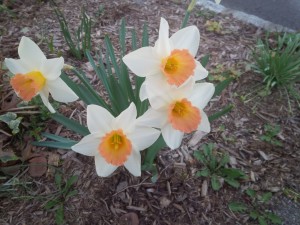
The first clumps of daffodils are blooming at long last and I have to resist the urge to go out and pick all of them for the house. Little nosegays of snowdrops and early crocus have been a welcome relief from grocery store flowers, but daffodils in a vase—especially a blue vase– radiate spring sunshine. Any daffodil restores the soul after a long winter, but I am especially looking forward to ‘Mrs. R.O. Backhouse’, a medium size daffodil named for a major figure in narcissus history.
Introduced in 1921, ‘Mrs. Backhouse’ has long been heralded as the first pink-cupped daffodil. That description conjures up images of the harsh, blue-pink shade most often depicted in catalogs, but those images are light years away from the reality of ‘Mrs. Backhouse.’ The “pink” cups vary somewhat in color according to soil, temperature and light conditions, but are generally a soft apricot pink, accented by ivory perianth or surrounding petals. ‘Mrs. Backhouse’ made a big splash at the time of its introduction, but the actual plants are subtle and elegant in the garden.
The daffodil is named for Sarah Elizabeth Dodgson Backhouse—1857-1921—a pioneering daffodil breeder. It was introduced by her husband and fellow hybridizer, Robert, after her death. Some sources suggest that she had a hand in breeding it. It is fitting that the beautiful, ground breaking daffodil was named after an accomplished, ground breaking woman.
A history professor of mine once said that it is a mistake to look at and judge other eras as refracted through the prism of our own time. I try to remember that when I think of Mrs. Backhouse. When Robert Backhouse christened his pink and white narcissus, he was following long-held garden tradition by calling it ‘Mrs. R.O. Backhouse’ instead of ‘Sarah Elizabeth Backhouse’. In the nineteenth and much of the twentieth century, most married women, except possibly actresses, went by their husbands’ names. In fact, “Mrs.” In front of a last name, was sometimes used by single women of a certain age, as it guaranteed a degree of respectability and ruled out the possibility that the user of the title suffered from the dreaded fate of being an “old maid.”
And so it was that Sarah Elizabeth Backhouse, the plant breeder, became ‘Mrs. R.O. Backhouse’, the daffodil. Her name is also attached to a golden-peach colored martagon or Turk’s cap lily and a snowdrop, ‘Mrs. Backhouse 12.’
But who was Mrs. R.O. Backhouse? There is not much to know of her before her marriage in 1884. Robert Ormston Backhouse, her husband, was born into a prominent Quaker family of bankers and plantsmen that included his father and grandfather, both named William. R.O. Backhouse was also a competitive archer, plying his bow in the 1908 summer games in London at the advanced age of 54. It isn’t clear whether Sarah arrived at plant breeding before or after her marriage. It is clear that she became very adept at it. Daffseek, the searchable database of the American Daffodil Society, credits her with nearly 270 introductions out of the 578 total for the Backhouse family.
The Backhouses were based at Sutton Court, an estate in the English County of Hertfordshire. In addition to birthing new narcissus and lily varieties, the couple had one child, William Ormston Backhouse, born in 1885. Not surprisingly, he also became a horticulturist.
Sometimes you can tell a lot about a plant breeder’s personality by looking at the traits he or she introduces into new varieties. Sarah Backhouse bred all types and colors of daffodils, and won prizes for a white-flowered variety called ‘Moonbeam,’ but she specialized in varieties with orange or golden orange cups. These were rather flashy creations from a woman who seemed to avoid the spotlight. After her death, an “In Memoriam” tribute to her in the RHS official publication, The Garden, read: “Few of the famous raisers of new varieties were less known on committees or at meetings, and it was not very often that she staged many flowers in public, but when she did, it was something like a revelation to see what was there.”
Not everyone can be credited with the production of “revelations.”
Sarah Elizabeth Backhouse lives on in her daffodils, especially her namesake variety, which is still commercially available. It is fitting that a female descendent, Caroline Thompson, has transferred a collection of original Backhouse daffodils to her garden at the Rofsie Estate, near St. Andrews in Scotland. A look at the estate’s website– http://www.rofsie-estate.com/ –suggests that Ms. Thompson and her family are in the process of building on the Backhouse connection and legacy.
Next fall consider inviting ‘Mrs. R.O. Backhouse’ into your own garden. Order from Old House Gardens, 536 Third St., Ann Arbor, MI 48103, 734-995-1486, www.oldhousegardens.com. Catalog $2.00.
